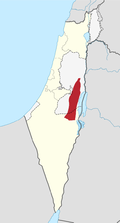Judaean Desert
The Judaean Desert is a desert in Israel and the West Bank that lies east of Jerusalem and the Judean hills and west of the Jordan Valley and Dead Sea.
|
The Judaean Desert overlaps the Negev in the south, to many of its parts the West Bank and partly the Dead Sea region in the east. To avoid duplication of information (and work), and because accessibility to this region is rather based on the previous three areas, use those latter articles to find (and maybe contribute) information. Consider this article more as a park guide that concentrates on the features and sights of the Judaean as a desert region. |

Cities and villages
Notable cities and villages throughout the Judaean Desert:
- 🌍 Arad – the only city in the Judean desert outside the Palestinian territories, located on the border of the Negev
- 🌍 Jericho – Palestinian city in the West Bank, located 10 km north of the Dead Sea. It is believed to be one of the oldest inhabited cities in the world - archaeological remains have been found of settlement in that area which dates back 11,000 years (9000 BC).
- 🌍 Ma'ale Adumim – Israeli city in the West Bank. It is the third largest Israeli settlement in the West Bank.
Understand
Despite its desert climate, many streams flowing from the Judaean hills and the Jerusalem hills have carved beautiful canyons and ravines through the soft rocks in the region.
Most of the attractions and sites throughout the Judaean Desert are located along the western shores of the Dead Sea. In addition to information about the attractions and sites in the Judaean Desert, this article provides expanded details regarding the various hiking trails in the Judaean Desert.
History
Though hostile and arid, the Judaean Desert was settled since before recorded history. Jericho, which was founded over 11,000 years ago (around 9,000 BCE), is one of the oldest continuously-inhabited cities in the world, and it is the first city in the world that had walls built to protect it. Another notable place is Ein Gedi, a large oasis that had cities built around it for over 6,000 years. Inside the desert itself there are numerous isolated monasteries, many are still active to this day.
The Judaean Desert played an important role in the Jewish kingdoms in Israel during the biblical times, and also during the Greek and Roman times.
Due to its rough terrain and climate, the Judaean Desert was known as a hiding place for refugees and rebels. In one famous Biblical story, King David fled here with his soldiers after King Saul ordered to have him killed. During the Greek and Roman times, the Hasmonean dynasty and the roman client King Herod the Great built and fortified many forts, strongholds and even palaces in the Judaean Desert, most famously, Masada. During the Roman-Jewish wars, the Jewish rebels fled to the Judaean Desert and fortified in the strongholds there. The last free standing Jewish stronghold in Jewish history, prior to the establishment of the modern state of Israel, was Masada.
Climate
| Judaean Desert | ||||||||||||||||||||||||||||||||||||||||||||||||||||||||||||
|---|---|---|---|---|---|---|---|---|---|---|---|---|---|---|---|---|---|---|---|---|---|---|---|---|---|---|---|---|---|---|---|---|---|---|---|---|---|---|---|---|---|---|---|---|---|---|---|---|---|---|---|---|---|---|---|---|---|---|---|---|
| Climate chart (explanation) | ||||||||||||||||||||||||||||||||||||||||||||||||||||||||||||
| ||||||||||||||||||||||||||||||||||||||||||||||||||||||||||||
| ||||||||||||||||||||||||||||||||||||||||||||||||||||||||||||
The coast of the Dead Sea offers many cold and hot springs.
The Judaean Desert has an average annual rainfall of 47mm. This is due to the fact that the rains in Israel, which comes from the Mediterranean Sea, are blocked by the Judaean mountains, creating a rainshadow desert over the eastern slopes of the mountains (the Judaean Desert), while the western slopes (the Shfela) receive an average annual rainfall of about 500mm. Because of that, the Judaean Desert contains a relatively large amount of oases, which are fed by the groundwater from the western slopes of the Judaean mountains.
Almost every year various travelers find themselves stuck in certain streams in the Judaean Desert when flash floods appear abruptly due to rain that occurred recently in the nearby Judaean hills and the Jerusalem hills. Some of these abrupt flash floods can be quite dangerous and even lead to deaths. Therefore, before hiking on the narrow streams in the Judaean desert, always make sure that no rain is expected to fall in the Judaean Desert or the nearby mountains.
Geography

The Judaean Desert is an array of hills and canyons, falling from the heights of around 1,000 meters in the Judean Mountains, to the Dead Sea which is, at -421 meters below sea level, the lowest place on earth. At its eastern edge, the Judaean Desert dramatically drops into the Dead Sea in cliffs of up to 500 meters, and waterfalls in the dry canyons fall in heights of 50-330 meters.
This cliff line was created as a result of the Great Rift Valley and the movement of the tectonic plates. The movement of the tectonic plates have created the valleys of the region, including the Dead Sea valley. This movement also created the sharp cliffs located at the eastern edge of the Judaean Desert, above the Dead Sea Valley.
Get in
The majority of the Judaean Desert is either in the Palestinian territories of Judea, or stretches along the Dead Sea. The only other civilized area is the town Arad.
By car
Route 90 crosses the entire Dead Sea basin from the Lido junction in the north to the Arava junction down south, and passes through almost all settlements that are not in Palestinian territories.
From the north the route can be accessed by driving southwards on route 90, that begins in Qiryat Shemona and passes by Beth Shean.
From Jerusalem and the coastal plain it can be accessed by driving eastwards on route 1, the road that goes from Tel Aviv to Jerusalem. Pass by Jerusalem following the road signs to the Dead Sea. In the Lido junction, turn right and you're on route 90, driving along the Dead Sea. Alternately, you can drive southwards towards Be'er Sheva on route 40 (or on the toll-road Route 6, which then connects to route 40), then take a left either on route 31 (going through Arad and connecting to route 90 in Zohar junction) or on route 25 (through Dimona to the Arava junction, on the southern end of the Judaean desert).
From the south, reach the Arava road (also part of route 90) and drive northwards, passing the Arava junction.
By bus
All following lines drive on route 90. All of them pass through the Ein Bokek hotel complex. The most frequent buses are from Jerusalem.
- From Jerusalem: lines 486, 487, 444
- From Be'er Sheva through Arad: lines 384, 386
- From Tel Aviv: line 421, going only once a day each way and very crowded during high season, departing from the bus terminal near the central train station.
Line 389 from the central bus station goes through Arad and departs only a few times each day. - From the Arava junction: line 444 arriving from Eilat, line 321 arriving from Dimona.
Get around
Best accessed by car, but some sites, especially along the western shore, can be reached with the bus.
See

Most tourist attractions in the Judaean Desert are located near the Dead Sea – look there for further information.
- 🌍 Kelt Oasis / Nahal Prat (Wadi Qelt) (between Jericho and Mitzpe Yeriho). This is a valley/stream between Jerusalem and Jericho, from where it runs into the Jordan River. It is home to a unique variety of flora and fauna, and St. George's Monastery and the 🌍 Wadi Qelt Synagogue (part of the "Jericho Royal Winter Palace" complex constructed in the Second Temple Period) can be found here. The latter is thought to be the biblical Perath mentioned in Jeremiah 13:5.
Do
See hiking in the Judaean Desert as well as the Ein Gedi nature reserve. Hiking in the region is recommended all year long except for the summer season and the exceptionally hot days. In addition, it is important to keep up to date with the weather forecast in advance, and to be aware of any flood warnings issued for the Judaean Desert.
Buy, eat and drink
Sleep
Arad has several accommodation options. Also Hebron, Bethlehem, Jerusalem and Jericho in the West Bank and at the border of the Judaean Desert offer a variety of places to stay.
Stay safe
- There are scattered Jewish settlements along highways 1 and 90, and the entire area (except around Jericho) is under Israeli military rule, making you feel at times as if you are in Israel. Nevertheless, one should always be aware that in the northern part of the Judaean Desert, which is located in the West Bank, there are various Palestinian towns and nomads, some of which are hostile to Israel. Still, the coastline of the Dead Sea and the areas around and south of Ein Gedi are quite safe.
- Sink holes exist along the Dead Sea coast. Do not walk anywhere east of route 90, unless there's a road or trail that leads there, as you might find the earth suddenly dropping beneath your feet as you step.
- The weather in the Judaean Desert tends to be very hot in the summer. Settlements are few and far-between, and no information exists on whether the (few) natural water sources are potable. Hence, travelers should dress appropriately and bring along water supplies.
- Flash floods can occur in the Judaean Desert rivers. The floods can be caused by rains falling in the Jerusalem area which would not be initially noticeable for the travelers at the Judaean Desert, and therefore it is important to check the weather forecast alerts regarding the Judaean Desert in advance.
- Large areas on the Judaean Desert plateau are closed Israeli military zones used for military training. No signs exist on hiking trails to warn travelers off these areas. Therefore, when planning a trip to any of the wilderness areas here, you must check in advance on an updated map of the region whether your intended route passes through a military zone. Entry is freely allowed to these areas only on Saturdays and on Jewish holidays (note that not all official vacations in Israel are actual Jewish holidays!). On all other days, one must pre-coordinate their entry to these regions with the responsible military unit, ☎ +972-2-5305372, +972-2-5305511. Note that you might not find an English speaker on the line!
- The Israeli Society for Nature operates the 🌍 Ein Gedi Field School (Just north of Ein Gedi), ☎ +972-8-6584288. – an education and travel information center for the Judaean desert area. Before traveling in the wilderness in the area, it's highly recommended to either visit the place or contact them by phone as they can supply you with all viable and up-to-date information about any traveling route.
Go next
- Dead Sea – to the eastern side of the Judaean, one of the most famous things to see/do in Israel and Jordan, including several other attractions
- Negev – a desert covering southern Israel, featuring amazing sites and desert landscapes, including Mitzpe Ramon at the edge of the Ramon Crater, and Eilat, a holiday town in the far south with border crossings to Jordan and Egypt
- West Bank – most parts of the Judaean Desert lie within the West Bank, most of which, in turn, is part of the Palestinian territories including destinations like Jerusalem, Bethlehem, Jericho and Nablus